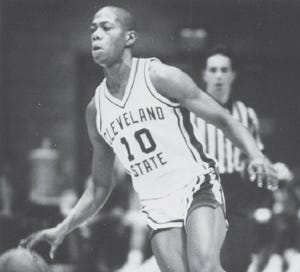Madness wasn’t attached to March just for a cute branding alliteration. The NCAA Tournament is a cultural phenomenon that appeals to even the most casual basketball fans for its unpredictability.
That a small Jesuit school in Jersey City can nearly make the Final Four gives March its mystique. The chaos also makes the NCAA Tournament must-see television. With games all throughout a four-day stretch each spring, March Madness is the perfect TV-viewing event.
In 1986, the full potential of the NCAA Tournament on TV was just beginning to be realized thanks to fledgling ESPN facilitating CBS coverage. However, viewers didn’t have access to the complete schedule as we do today.
Fortunately, the first true March Madness upset played out for a national cable audience in a game that set the standard for the Tournament’s opening days.
Five double-digit seeds scored 1st Round wins in 1985, the first year that the NCAA Tournament expanded to 64 teams. None are what anyone could reasonably deem a Cinderella:
No. 11 Boston College beat Texas Tech in the Midwest Region, 55-53
No. 11 Auburn beat Purdue in the Southeast, 59-58
No. 11 UTEP beat Tulsa in the West, 79-75
No. 12 Kentucky beat Washington in the West, 66-58
No. 13 Navy beat LSU in the Southeast, 78-55
So that’s three teams that in present-day terms are deemed power-conference programs, a UTEP program with a legendary head coach and consistent postseason presence, and a Navy team built around sophomore David Robinson, who was already one of the best players in the nation with averages of 23.6 points, 11.6 rebounds and four blocked shots per game.
Cinderella, as we know the concept today, began on March 14, 1986. That was the first time in the restructured bracket that a No. 14 seed upset a No. 3 — and there were two such outcomes that day.
The less famous of the two saw Arkansas-Little Rock, champion of the Trans America Athletic Conference1, take down Notre Dame, 90-83.
The third-seeded Fighting Irish rallied from a seven-point deficit — which, with this being the last season before the introduction of the 3-point line at the college level, was a four-possession difference — at the 8-minute mark.
Now, any experienced March Madness watcher knows double-digit seeds that cough up a late lead in that early-tipoff window is typically headed to defeat. But after coughing up its advantage, UALR roared back with a game-changing, five-point burst capped when Trojan Pete Myers knocked down a jump and was fouled by Notre Dame’s Jim Dolan2.
In the Fighting Irish forward’s defense, the costly and-one foul is far from the biggest error someone named James Dolan has ever committed in the game of basketball.
Myers’ 3-point play was part of a 29-point effort from the UALR wing, leading a Trojan trio of 20-plus-point scorers. Michael Clarke added 27 points and Myron Jackson went for 22.
I note the Arkansas-Little Rock win and spotlight its standouts because the Trojans’ historic upset fell into the background of March lore almost immediately.
Notre Dame wasn’t exactly some no-name program, nor was its basketball an afterthought in 1986. Digger Phelps had the Irish on the cusp of being truly among the sport’s elite throughout his tenure, and superstars like Austin Carr and Adrian Dantley were some of college basketball’s biggest names in the 1970s.
But Notre Dame wasn’t Indiana.
The 1986 season marked the 10-year anniversary of the Hoosiers’ perfect national title run. It had been only five years since Isiah Thomas paced the ‘81 Hoosiers to a second national championship under Bob Knight’s direction.
But finishing 19-14 in 1984-85 — 15-13 at the conclusion of the regular season before a deep NIT run — including 7-11 in the Big Ten weighed heavily. Knight’s antics exacerbated the situation, with the infamous Chair Throwing episode coming in the 1984-85 campaign.
The tumult in Bloomington prompted John Feinstein to spend the 1985-86 season chronicling Indiana’s exploits for his book, A Season on the Brink.
The Hoosiers rebounded effectively enough — not back to anything approaching their 1976 heights, but enough to step away from the brink. A second-place finish in the Big Ten landed Indiana a No. 3 seed in the NCAA Tournament and a matchup with Mid-Continent Conference champion Cleveland State.
A necessary preface is in order: The Vikings were woefully under-seeded. This makes the magnitude of their win over Indiana no less historic — see also: UMBC as the first No. 16 seed to beat a No. 1, knocking off Virginia in 2018.
Still, at 27-3 going into the Big Dance, Cleveland State wasn’t a Cinderella in the vein of 2001 Hampton or 2023 Fairleigh Dickinson.
And, to that end, a shoutout is in order for Blue Ribbon College Basketball Yearbook editor Chris Wallace. In the week leading up to the 1986 NCAA Tournament, Wallace told the San Francisco Examiner:
“Here’s a team of kids no one except their parents know about. But they have one of the best guards in college basketball — Ken McFadden. He didn’t play school basketball, but he has them leading the nation in scoring.”
Wallace pinpointed Cleveland State-Indiana as a game for TV viewers to watch, with it made available nationally via ESPN. And oh, how prescient Wallace was.
Ken McFadden is better known as Mouse McFadden, and he’s the face of Cleveland State’s 83-79 upset. With a nickname like Mouse and an energetic style of play that matches the symbolism, how could he not be?
Interestingly enough, though, McFadden’s star performances in the 1986 NCAA Tournament came in a Round of 32 win over Saint Joseph’s, and Cleveland State’s near-miss against David Robinson and Navy in the Sweet 16.
McFadden scored 23 points on 10-of-15 shooting vs. St. Joe’s, then had 16 points against Navy. Against Indiana, he scored a modest nine points.
Clinton Ramsey’s 27 points and Eric Mudd’s double-double of 16 points and 10 rebounds led the way against Indiana.
Who starred for Cleveland State is less important than the precedent the Vikings set as a team.
In knocking off a true blue-blood program, Cleveland State proved that anything can happen in the new, 64-team NCAA Tournament.
CSU captured the nation’s imagination, thanks in part to having the captive, national audience for its matchup with Indiana, and became a media darling on its run.
Then, a year-and-a-half later, Cleveland State was hit with severe NCAA penalties for violations allegedly committed four years earlier, involving the recruitment of Manute Bol, a player who never suited up for the Vikings.
The severity of CSU’s sanctions — a two-year NCAA Tournament ban and year-long TV exile — became a rallying cry for opponents of college sports’ governing body. Jerry Tarkanian once famously quipped, “The NCAA is so mad at Kentucky, it’s going to give Cleveland State two more years’ probation.”
Implied in Tarkanian’s shot at the NCAA is that, while the Cinderella stories like Cleveland State are the life blood of March Madness, they play with a set of rules different from the traditional power, well-financed members.
As the threat of changes to the NCAA Tournament loom, all of which are likely designed to benefit the big-money institutions, Cleveland State is the forefather to the modern Cinderella in more ways than just being the first high-profile double-digit seed to score a major upset.
The TAAC rebranded as the Atlantic Sun in 2001 and is now the ASUN. The only member from the 1985-86 season still there is Stetson. Two members in ‘85-’86 — Hardin-Simmons and Centenary — are now Div. III.
Bubble Babble: Stetson Hatters First Dance Was A Half-Century In The Making
It may not be one of the 1939 originals, but Stetson basketball earning its first-ever NCAA Tournament bid in program history is no insignificant milestone.
There’s something quaint and perhaps even a bit sad that in 1986, a conference with membership entirely in the South qualified as “Trans America,” given we’re headed toward leagues that span from Tucson to Orlando; Newark, Delaware, to Las Cruces, New Mexico; and Pisacataway, New Jersey, to Los Angeles.




